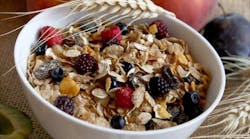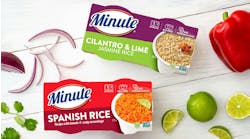Fiber is essential to the diet, and fiber content can be an important marketing point in a processed food. But not all fiber is created equal, and since 2016, the FDA has made it clear that a fiber ingredient that is not naturally occurring and intact must be scientifically demonstrated to have a health benefit before it can be called “fiber” on a label.
“Fibers vary. Some lower cholesterol more than others. Some lower blood pressure more than others. Some of them do several things, and some only do one,” explains Julie Miller Jones, emeritus professor of nutrition at St. Catherine University in St. Paul, Minn. and a member of the Grain Foods Foundation’s Scientific Advisory Board.
Understanding some of the regulatory issues around fiber is essential for food manufacturers who want to tap fiber’s potential as a label-enhancing ingredient.
Two kinds of fibers
Fiber is a carbohydrate that is not digested in the upper gastro-intestinal tract of the human body. Soluble fiber, which occurs in oats, barley, citrus fruits, beans and some other natural ingredients, forms a gel-like substance in your digestive system and can help lower cholesterol and glucose levels. Non-soluble fiber, which shows up in whole wheat, nuts, beans and some other vegetables, helps move material through your digestive system. Both are important to health.
Before the FDA began regulating fiber, manufacturers determined for themselves what was fiber and could use the term on labels whenever they decided it was appropriate. Eventually, the FDA decided this practice was misleading consumers.
“The FDA developed the concept that some things are labeled dietary fiber that are not dietary fiber,” explains George Salmas, managing principal of Salmas Law, which specializes in food and beverage law.
“For example, isomalto-oligosaccharide (IMO). It was extremely popular in protein bars. It was supposed to be a low-glycemic effect, non-digestible, high-fiber ingredient. It sold like crazy. Ultimately the FDA determined it’s not a dietary fiber – just a digestible carbohydrate.”
In 2016, the FDA released its definition of dietary fiber, which identified two general classes of fiber: naturally occurring fibers that are “intrinsic and intact” in plants and “isolated or synthetic non-digestible carbohydrates (with three or more monomeric units) determined by FDA to have physiological effects that are beneficial to human health."
The first category – plant fiber that is intrinsic and intact – occurs in foods such as vegetables, whole grains, fruits, cereal bran, flaked cereal and flours. It is considered "intact" because this kind of fiber has not been removed from the food. According to the FDA, “foods containing these fibers have been shown to be beneficial, and manufacturers do not need to demonstrate that they provide beneficial physiological effects to human health.”
The second category of fiber – isolated or synthetic – includes non-digestible carbohydrates that are separated from their original plant form or that do not arise naturally in plants. These are commonly used in processed foods to boost fiber content or otherwise improve the product. The FDA allows these ingredients to be called fiber only if they have a “beneficial effect on human health,” such as lowering cholesterol or glucose levels, increasing frequency of bowel movements, or improving mineral absorption.
Initial list of approved fibers
When the 2016 definition of dietary fiber was released, the FDA also released a list of seven fibers in the isolated or synthetic category that the agency determined had scientifically proven health benefits:
- Beta-glucan soluble fiber
- Psyllium husk
- Cellulose
- Guar gum
- Pectin
- Locust bean gum
- Hydroxypropylmethylcellulose
All ingredients on that initial list are fundamental ingredients for food processors.
“Guar gum, for example, has super properties in terms of reducing cholesterol, and it makes the food gummy, so it’s perfect for ice cream and salad dressings,” Jones says. “Locust bean gum tends to be used more in candies, ice cream and yogurt.”
Later in 2016, the FDA asked for citizen petitions to add other ingredients to the approved list, and manufacturers responded with a slew of filings. Among the petitions was one for inulin, a fiber found in chicory root that is used in baby foods, yogurt, cereals, ice cream, baked goods and other processed foods.
The petition for inulin, which succeeded in having that ingredient added to the list, was submitted by a consortium of chicory root-based inulin producers or suppliers, including Beneo.
Photo: Beneo
“The FDA concluded in the response letter to the citizen petition, ‘The strength of the evidence supports that inulin and inulin-type fructans have a statistically significant effect on calcium absorption and bone mineral density that is beneficial to human health,’” explains Anke Sentko, vice president of regulatory affairs & nutrition communication for Beneo.
Sentko says their petition included other nutritional benefits of inulin, but once the FDA decided the ingredient helped with mineral absorption – one of the criteria for inclusion – it approved the ingredient without addressing the additional benefits.
“One of the reasons inulin is a darling of food processors is it’s easy to add,” Jones says. “It’s colorless, a little gummy and can substitute for sugar in some applications. So there are a lot of functional reasons why a processor might add it.”
Another petition promoted the addition of glucomannan to the approved fibers list. That ingredient, which is a soluble fiber made from a hemicellulose component in plant cell walls, was put forward in a petition prepared by Salmas on behalf of a client.
“Glucomannan wasn’t on the initial FDA dietary fiber list,” Salmas explains. “So my client was faced with the prospect of their high-fiber food suddenly not containing any fiber on the label. Because glucomannan had been sold in food for many years, there are many peer-reviewed science journal papers reporting on clinical studies of how glucomannan affects human physiology.”
Eight more for 2018
The second list, released in June 2018, includes eight fiber ingredients the FDA proposes to add to the original list:
- Mixed plant cell wall fibers (a broad category that includes fibers like sugar cane fiber and apple fiber, among many others)
- Arabinoxylan
- Alginate
- Inulin and inulin-type fructans
- High amylose starch (resistant starch 2)
- Galactooligosaccharide
- Polydextrose
- Resistant maltodextrin/dextrin
In the two years since that list was released, glucomannan and cross-linked phosphorylated RS4 have been added, bringing to 10 the number of ingredients on the proposed list.
An example of one of the newly listed fibers is resistant maltodextrin such as Fibersol, produced by a joint venture between ADM and Matsutani America Inc. The ingredient helps maintain intestinal regularity, blood glucose levels and serum triglycerides. Fibersol also is recognized as a “low FODMAP ingredient” by Monash University, which means it does not aggravate the gut or cause irritable bowel syndrome symptoms.
“Fibersol can be used in virtually any food or beverage application to increase fiber content and improve the nutritional profile without negatively impacting taste or texture,” says Sarah Diedrich, marketing director for sweetening solutions & fibers at ADM. “Since it is heat-, acid-, shear- and freeze/thaw-stable, it requires minimal formulation and process adjustments.
"Fibersol provides simplified fiber fortification in breads, muffins and more, given its low viscosity and water solubility," she continues. "It contributes moistness and can replace much of sugar’s functionality, allowing for sugar reduction by as much as 25 percent in bakery and snack products.”
MGP Ingredients' Fibersym RW, is a granular RS4-type resistant wheat starch.
Another low FODMAP ingredient composed of a fiber on the proposed list is Novelose 3490, introduced in June by Ingredion. Novelose 3490, which is an insoluble fiber derived from tapioca, is a type 4 resistant starch.
“Novelose 3490 dietary fiber is a versatile, affordable resistant starch that can be used in a wide variety of bakery and snack applications – without compromising taste, texture or appearance,” according to the company.
Another resistant starch product is Fibersym RW from MGP Ingredients Inc. Fibersym has been on the market since 2003, and is commonly used in breads, pizza crust, tortillas, pasta, cereals and other processed foods.
“Food formulators value Fibersym’s functional attributes,” says Ody Maningat, chief science officer and vice president of R&D for MGP Ingredients. “Its contribution to product crispiness, white appearance and smooth texture, combined with low water-holding properties, require minimal processing adjustments.”
A new line of fiber products from EverGrain Ingredients, EverVita Fibra and EverVita Pro, are made up of fibers from the mixed plant cell wall fibers category of the new fibers list.
“EverVita Fibra is a high-fiber (60 percent) product that can be easily integrated into any flour blend and labeled as ‘barley fiber,’” says Giacomo Cattaneo, global director, EverGrain. “EverVita Pro, in addition to fiber, has a higher protein content (35%) and can thus be labelled as ‘barley fiber and protein.’ The composition of the fiber is the insoluble fraction naturally occurring in barley, primarily in hemicellulose called Arabinoxylan, cellulose and lignin.”
EverGrain's, EverVita Fibra and EverVita Pro, are made up of fibers from the mixed plant cell wall fibers category of the new fibers list.
Cattaneo says the barley fiber ingredients in EverVita are produced from malted barley and has had its starch removed.
“Our development process maintains everything exceptional that is inherent in barley and elevates the nutritional profile around fibers and proteins,” Cattaneo says. “The result is a product that has a clean, slightly malty taste.”
Label usage approved
When the FDA released the proposed list, the agency made clear it would practice “enforcement discretion” with companies that use those ingredients and include them as fiber on the product label. The phrase “enforcement discretion” means the companies are allowed to use those ingredients without fear of being sued, Salmas explains.
“The reason the second list is ‘proposed’ is because the FDA still has to complete the rulemaking process for those to be added to the official list that appears in the Code of Federal Regulations,” Salmas says.
“The first list is already in the Code of Federal Regulations; when the FDA finishes with the rulemaking, the second list will be, too. It’s just pro-forma," he continues. "For now, the FDA has said, ‘OK people, these aren’t in the Federal Register yet, however if you label it as dietary fiber, we’ll let you do it.’ So it’s as good as being part of the rule.”
Can other fiber ingredients be added to the list? Yes, the opportunity to submit citizen petitions for adding fibers is open-ended, Salmas explains, so eventually more could be added. In fact, the FDA is considering others already, according to Danielle Schor, a spokesperson for the FDA's Center for Food Safety and Applied Nutrition.
“The agency has received additional citizen petitions that have requested that the following isolated or synthetic non-digestible carbohydrates be added to the list of those that meet the regulatory definition of ‘dietary fiber’: D-tagatose, arabinogalactan and alpha-cyclodextrin,” Schor says.
The process to get ingredients added to the list has not always been smooth. Beneo’s Sentko notes the process did not come without consequences:
“The process of evaluation and implementation was long and complex,” Sentko says. “This created a lot of uncertainty in the market and delayed new product developments. This was of concern for ingredient manufacturers and their customer, the food industry, and slowed down the development of fiber-enriched products to the disadvantage of consumers.
"The fiber gap is still a concern and reflected in the discussions in the U.S. Dietary Guidelines Advisory Committee’s Scientific Report,” she concludes.


